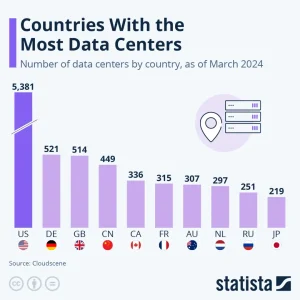Post Views: 339
Which Countries Lead the World in Data Centers and Why It Matters
Data centers are the backbone of today’s digital infrastructure—they store, process, and distribute the information that powers essential services, from email to video streaming to the massive systems behind artificial intelligence. Whenever you upload a file to the cloud, make an online purchase, or simply browse a website, you’re tapping into the computing power of one (or more) data centers located around the globe.
Below, we explore which countries have the most data centers according to VoronoiApp, and examine the key factors driving each country’s position.
1. United States
It comes as no surprise that the United States tops the list. With tech giants such as Amazon, Microsoft, Google, and Meta, the country is a global epicenter for data centers.
- Key factors: Extensive infrastructure, access to capital, a highly skilled workforce, and strong domestic demand for digital services.
2. Germany
Often referred to as Europe’s economic powerhouse, Germany boasts a rapidly growing tech industry and a high concentration of data centers.
- Key factors: An expanding Industry 4.0 sector, a large industrial base, and data protection regulations (GDPR) that encourage local infrastructure.
3. United Kingdom
The United Kingdom stands out for its strategic location and strong connectivity to Europe and the rest of the world.
- Key factors: Favorable technology legislation, proximity to large financial markets, and a robust culture of digital adoption.
4. China
With the largest population globally and a booming e-commerce sector, China has emerged as a key player in data center expansion.
- Key factors: Huge consumption of digital services (fintech, social media, streaming), strong local investors, and governmental emphasis on technological sovereignty.
5. Canada
Canada’s data center market is strengthened by its abundant energy resources and proximity to the U.S., as well as its growing tech ecosystems in cities like Toronto and Vancouver.
- Key factors: Ample supply of clean energy, policies that encourage innovation, and economic stability conducive to technology investments.
6. The Netherlands
The Netherlands has established itself as a tech hub in Europe thanks to its solid telecommunications infrastructure and strategic location. Amsterdam, in particular, serves as a major node for internet traffic in the region.
- Key factors: Robust connectivity, tax incentives, and a prime position in Western Europe.
7. Australia
Although geographically isolated, Australia is seeing noteworthy growth in data centers, driven by local demand and the desire to expand infrastructure in less saturated regions.
- Key factors: Increasing cloud adoption, incentives for foreign investment, and a stable economy.
8. France
France benefits from strong governmental support for digital transformation. Paris and Marseille, for instance, are crucial interconnection points for network traffic across Europe.
- Key factors: High domestic demand, key interconnection nodes, and a policy environment that supports new tech ventures.
9. Japan
Japan’s advanced technology infrastructure, combined with a high appetite for digital services, secures its place among the leading Asian countries for data centers.
- Key factors: Innovation in telecommunications, significant IoT and robotics development, and a highly urbanized population.
10. Switzerland
Known for its political and financial stability, Switzerland is an attractive destination for data centers focused on privacy and security.
- Key factors: Stringent data protection laws, international reputation for stability, and strong domestic consumption.

Why It Matters for Your Cloud Services
If your business or projects are hosted in the cloud, your data is likely housed in one of these major data center markets. Understanding which countries dominate the data center landscape can help you:
- Optimize latency
The closer your servers are to your primary audience, the faster your site or application will respond. - Comply with regulations
Certain regions require that data be stored locally, which is crucial when handling sensitive or regulated information. - Plan for scalability
Knowing where telecommunications and energy infrastructure is best can be pivotal for sustainable, long-term growth—especially as the demand for data processing and storage continues to escalate.
Conclusion
Data centers are the engine of the global digital economy. Countries like the United States lead with colossal infrastructure, while Germany’s industrial base and the UK’s connectivity also stand out. Meanwhile, Canada, the Netherlands, and other tech-forward nations continue to build capacity with policies and resources that favor the data center industry.
For anyone relying on cloud services—whether for personal projects or enterprise-level operations—being aware of data center locations can substantially impact performance, security, and regulatory compliance. As our world becomes more interconnected and data usage grows exponentially, making informed decisions about where your data lives will only become more critical.
References
- VoronoiApp: Which Countries Have The Most Data Centers?
- IDC, Global Data Center Trends & Forecast (for worldwide data center statistics)
- General Data Protection Regulation (GDPR), Official Website
This article is based on information provided by VoronoiApp and publicly available sources on technology infrastructure.

